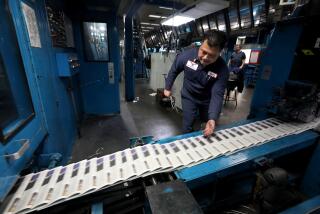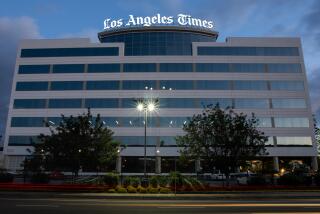Woes of N.Y. Daily News Go Way Beyond Current Strike
NEW YORK — Twenty days and more than 64 arrests into the violent strike between the New York Daily News and its labor unions, a basic question remains curiously in doubt:
Even if the Daily News wins everything it wants from the nine unions, can the nation’s third-largest metropolitan daily make enough money to survive, particularly when management agrees that it needs a new plant and presses?
Some experts say it is uncertain at best that the paper can ever be profitable enough to justify the $300-million to $500-million investment in a new plant that it needs to compete.
And if the paper did not survive the strike, most analysts and newspaper executives believe, Chicago-based Tribune Co., which owns the paper, would not be entirely unhappy. For one thing, they say, it would have sent a message to the rest of its enterprises that it will be extremely tough on unions.
“I believe they are going to come back,” said New York Post Publisher Peter S. Kalikow. “But I don’t know in what form.”
“There is potential out there, but that is long term, not in the near future,” said J. Kendrick Noble Jr., an analyst with Paine Webber.
Some say that if it is to survive, this celebrated paper--the archetype of the loud, working-class tabloid--will have to shrink into a much smaller product, perhaps to a third of its size only a few weeks ago.
In a telephone interview, Daily News Publisher James Hoge strongly disagreed with that assessment. He pointed out that his company had spent $55 million on two proposed plant sites as proof that Tribune Co. is “anxious to make the investment” in the News.
“I can’t give you a date,” Hoge said, “but we are looking (at investing in a new plant) within a reasonable period of time after getting our labor costs down.”
Hoge’s boss, Tribune Co. President and Chief Executive Charles T. Brumback, is more cautious. He told analysts in a meeting last spring that if his company succeeded in its goal of reducing labor costs and winning control over hiring, staffing and work rules, it would then wait another year or two to see if the paper were profitable enough to justify making a long-term investment.
“They should be able to make a profit,” said John Reidy, a newspaper industry analyst for Smith Barney, Harris Upham & Co. But “you don’t invest $400 million so you can make a profit of $40 million.”
Thus, a key issue is the level of profits.
Tribune management has told analysts privately that it believes the Daily News can earn a pretax profit margin of roughly 10%. Hoge, in this interview, declined to give specific numbers.
But most analysts believe that management’s numbers are too high.
“I think it will probably be something closer to 5%, and that wouldn’t happen overnight” said Kenneth T. Berents, vice president and senior analyst for the Baltimore investment firm Alex. Brown & Sons, echoing the sentiment of other analysts. “It will take two to three years to get to that level if at all.”
“I think that is one person’s guesses,” Hoge said. “I don’t know how we would know. We would expect to do better.”
The numbers game goes something like this: News management alleges that its labor contracts contain $50 million to $70 million worth of “abuses.” A year ago, the paper had revenue of about $400 million and was roughly breaking even.
Hence, if the paper were to eliminate those excess labor costs, it would have a profit of $50 million to $70 million, or between 12.5% and 17.5%.
Now, add in the cost of the new presses and plant. At $300 million to $500 million, newspaper executives say, that investment would cost the News roughly $30 million to $50 million a year in debt service. Depending on which estimates one picks, that would leave the News from zero to $40 million in profit.
“It would be absolute lunacy to invest that money without understanding that at least now you have opened up a significant gap between costs and revenues,” said Peter Falco, who analyzes the newspaper industry for Merrill Lynch. “And even then it is a chancy investment.”
But there are complications, most analysts believe. First, the economy in New York has weakened substantially in the past two years, reducing the paper’s revenue. The News’ circulation, which accounts for roughly half the total, has also declined in the past year by 100,000 to 1.09 million.
Analysts now estimate that revenue is closer to $320 million to $360 million a year.
Next, analysts such as John Morton of the brokerage Lynch, Jones & Ryan note that newspapers in New York typically lose circulation after a strike. Already, the New York Post has gained nearly 200,000 buyers a day, and its advertising has doubled. New York Newsday is up about 120,000 in circulation and about 40 pages in advertising.
How much of that the News could regain is unclear. Currently, the News is printing only 700,000 papers a day, and Hoge said he could not estimate how many were being delivered. Executives at other papers estimate deliveries at less than 300,000.
So if the News survived the strike, what would be left? One executive at a rival paper who has studied the News strategy believes that the paper could emerge from the strike at about two-thirds of its previous size, with circulation of about 750,000 concentrated in Brooklyn, Queens, parts of Manhattan and parts of western Nassau and Suffolk counties in Long Island. These are the area primarily served by the News’ biggest traditional advertisers.
But other newspaper professionals say these are the same markets sought by New York Newsday, a paper still losing money but subsidized by Newsday on Long Island. These papers are owned by Times Mirror Co., publisher of the Los Angeles Times.
Hoge again said these estimates of a leaner Daily News are wrong.
“I believe that there is significant circulation that we have not had because our (delivery) service cannot be adjusted to market needs,” Hoge said. For instance, he argued, union work rules that bar drivers from carting newspapers into retail establishments mean that the News is not available in many supermarkets.
“Our vision has been that the Daily News, if run efficiently, can . . . remain a million-plus (circulation) newspaper within a growing population of the New York metropolitan region,” he said.
Many analysts believe that Tribune Co. might as well pursue its confrontational approach, because it stands to win either way.
Success would leave Tribune Co. with a major paper in the country’s biggest city, plus ownership there of a profitable radio station and TV station. Federal regulations that were instituted after Tribune Co. already owned these would forbid any other company from duplicating such a combination.
And the worst-case scenario, closing the paper, is not entirely a negative for the parent. In addition to allowing Tribune Co. to claim that striking employees are no longer entitled to severance, “the other thing they have accomplished is they have left no doubt in the minds of other Tribune operating companies that unions won’t be tolerated,” said an executive at a rival paper.
Tribune’s stock price has hardly moved in reaction to the strike, a fact that several analysts take as a sign that the most cold-blooded barometer of all, the stock market, sees the paper’s death as no worse than its survival.
“Closure is definitely an option,” Paine Webber analyst Noble said.
The strike itself is also costly. The Wall Street Journal said Tribune Co. spent $24 million preparing for it. One rival newspaper executive believes that the strike is costing the Daily News $3 million to $5 million a week.
More to Read
Sign up for Essential California
The most important California stories and recommendations in your inbox every morning.
You may occasionally receive promotional content from the Los Angeles Times.










